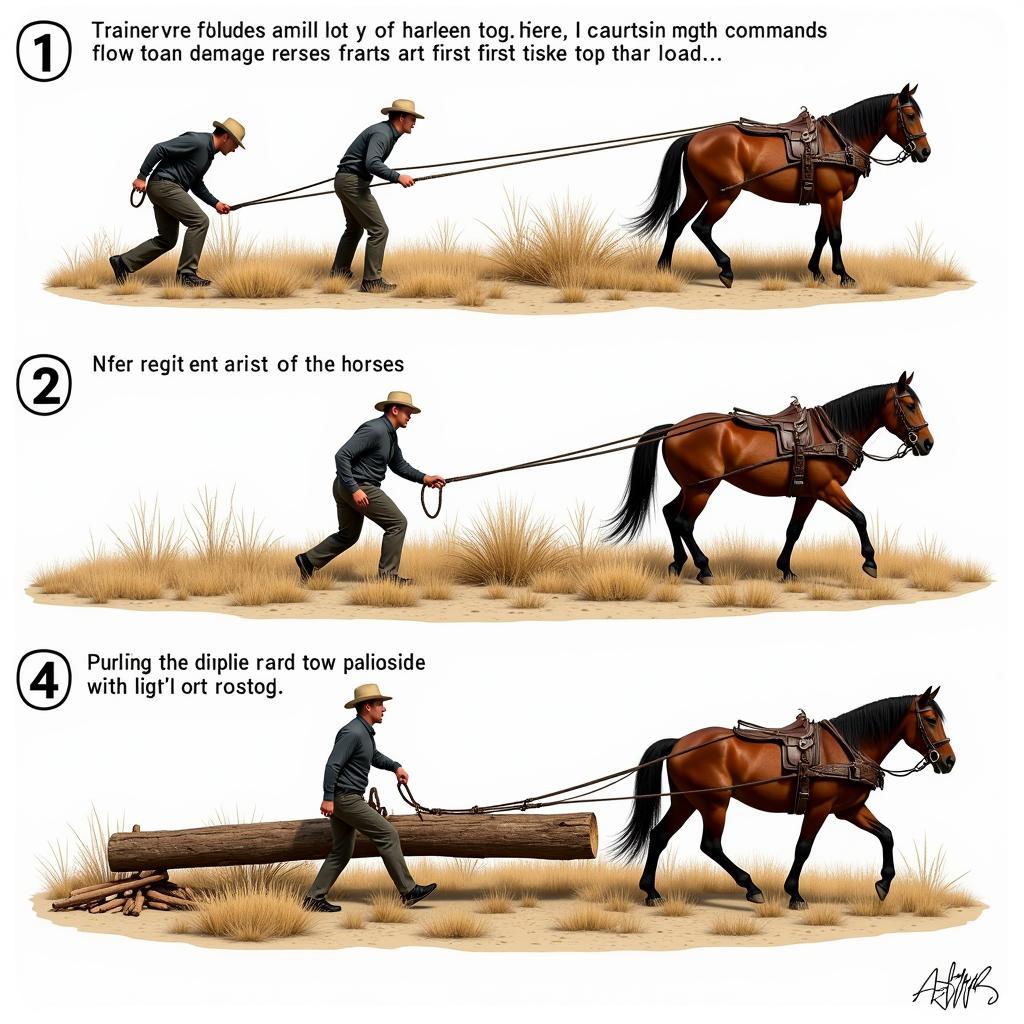A Work Harness Horse is more than just an animal; they are a partner, a powerhouse, and a testament to the enduring bond between humans and equines. From plowing fields to logging timber, these horses have played a crucial role in shaping our world. This article delves into the world of the work harness horse, exploring their history, breeds, training, and the essential equipment that enables them to perform their duties safely and effectively.
History of Work Harness Horses
For centuries, work harness horses have been essential to agriculture and industry. Their strength and stamina made them invaluable for tasks that required significant pulling power. From the medieval warhorse to the modern draft breeds, these animals have a rich and varied history, adapting to the changing needs of human society. These powerful animals have been instrumental in everything from building nations to feeding families. They represent a connection to a simpler time, a time when horsepower meant exactly that.
Choosing the Right Work Harness Horse: Breeds and Temperament
Selecting the appropriate breed for your work harness horse is crucial. Breeds like Clydesdales, Percherons, Belgians, and Shires are renowned for their strength, size, and gentle temperament, making them well-suited for heavy work. Temperament is equally important. A calm, willing horse is easier to train and safer to work with, ensuring a productive and enjoyable partnership. Thinking about installing solar lighting for your horse arena? Check out our horse arena solar lighting.
Essential Work Harness Components: Collars, Hames, and Traces
The work harness itself is a complex piece of equipment, each part designed to distribute the load evenly and efficiently. The collar is arguably the most important part of the harness, protecting the horse’s windpipe and shoulders while allowing it to pull effectively. The hames fit snugly around the collar, providing attachment points for the traces, which connect to the implement being pulled. Each component plays a vital role in maximizing the horse’s power and ensuring its comfort. Do you have a horse that’s proving difficult to train? A problem horse trainer can help.
Harnessing Your Horse: A Step-by-Step Guide
Properly harnessing your horse is essential for its safety and performance. First, position the collar correctly on the horse’s shoulders, ensuring a snug but comfortable fit. Then, attach the hames to the collar, making sure they are securely fastened. Finally, connect the traces to the implement, ensuring they are of equal length and properly adjusted.
- Place the collar gently on the horse’s shoulders.
- Secure the hames around the collar.
- Attach the traces to the implement being pulled.
This careful process ensures the horse can work comfortably and efficiently.
Training Your Work Harness Horse: Patience and Consistency
Training a work harness horse requires patience, consistency, and a deep understanding of equine behavior. Start with basic ground work, teaching the horse to respond to voice commands and pressure cues. Gradually introduce the harness and the weight of the implement, allowing the horse to acclimate to the feeling.  Training a Work Harness Horse Positive reinforcement and clear communication are key to building a strong working relationship. Looking for reliable work harnesses? Explore our range of work harness for horses.
Training a Work Harness Horse Positive reinforcement and clear communication are key to building a strong working relationship. Looking for reliable work harnesses? Explore our range of work harness for horses.
Caring for Your Work Harness Horse: Nutrition and Maintenance
Providing proper nutrition and care is essential for maintaining the health and well-being of your work harness horse. A diet rich in hay, grain, and fresh water is crucial to fuel their demanding work. Regular grooming, hoof care, and veterinary check-ups are also essential for keeping them in peak condition.
Conclusion: The Enduring Legacy of the Work Harness Horse
The work harness horse remains a powerful symbol of strength, resilience, and the enduring partnership between humans and animals. By understanding their history, breeds, training, and the essential equipment they require, we can ensure these magnificent animals continue to thrive and contribute to our world for generations to come. Proper care and training are vital for ensuring the longevity and well-being of your work harness horse.
FAQ
- What are the most common breeds of work harness horses? Clydesdales, Percherons, Belgians, and Shires.
- What is the most important part of a work harness? The collar, as it protects the horse’s windpipe and shoulders.
- How do you train a work harness horse? With patience, consistency, starting with groundwork and gradually introducing the harness and weight.
- What is the key to a successful partnership with a work harness horse? Clear communication and positive reinforcement.
- What are the dietary needs of a work harness horse? A diet rich in hay, grain, and fresh water.
Have you ever wondered how to hitch horses for a specific task? Our hitch horses daily themed crossword might offer some insights! Interested in using solar energy for your horse’s water? Learn more about our solar horse water heater.
For any assistance or inquiries regarding horse care, harnesses, or any related product, please contact us. Call us at: 0772127271, email us at: [email protected], or visit us at: QGM2+WX2, Vị Trung, Vị Thuỷ, Hậu Giang, Việt Nam. Our customer service team is available 24/7.